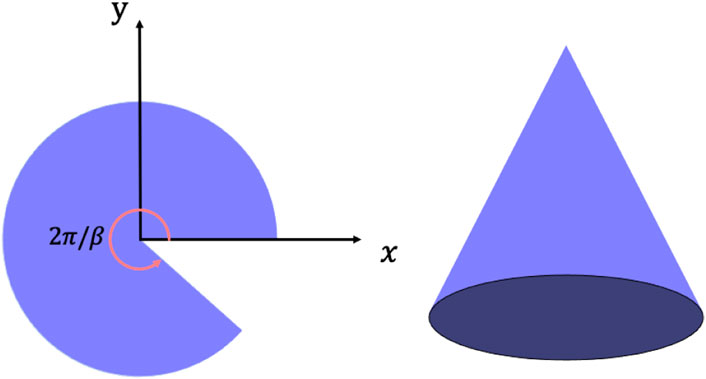- 1Department of Physics and Chongqing Key Laboratory for Strongly Coupled Physics, Chongqing University, Chongqing, China
- 2GBA Branch of Aerospace Information Research Institute, Chinese Academy of Sciences, Guangzhou, China
Generally speaking, entanglement entropy (EE) between two subregions of a gapped quantum many-body state is proportional to the area/length of their interface due to the short-range quantum correlation. However, the so-called area law is violated logarithmically in a quantum critical phase. Moreover, the subleading correction exists in long-range entangled topological phases. It is referred to as topological EE which is related to the quantum dimension of the collective excitation in the bulk. Furthermore, if a non-smooth sharp angle is in the presence of the subsystem boundary, a universal angle dependent geometric contribution is expected to appear in the subleading correction. In this work, we simultaneously explore the geometric and edge contributions in the integer quantum Hall (IQH) state and its edge reconstruction in a unified bipartite method. Their scaling is found to be consistent with conformal field theory (CFT) predictions and recent results of particle number fluctuation calculations.
1 Introduction
Quantum entanglement is a fundamental and important tool to probe the properties of a variety of physical systems such as black holes in astrophysics, quantum phase transition in condensed matter physics, and photosynthesis in biophysics [1]. In a bipartite system, one usually calculates the von Neumann entropy or the α-Rényi entropy to quantitatively describe the magnitude of the entanglement between two subsystems. Once the system size is smaller than the correlation length, the entropy is proportional to the volume of the system. For a gapped state, it is generally proportional to the area/length of the interface between two subsystems. This is referred to as the area law in a three-dimensional or perimeter law in a two-dimensional system. Heuristically, this could be understood from the fact that an energy gap gives rise to a finite correlation length which defines the scale on which particles inside the subsystem are correlated with the environment. In gapless critical systems, such as quantum Hall edges or critical spin systems which could be described by the conformal field theory (CFT), it is known that the EE has a logarithmic dependence on the boundary length, and the prefactor is related to the central charge of its underlying CFT [2–5].
After the discovery of topological quantum systems, such as the fractional quantum Hall effects [6, 7], it is known that there is an extra correction of the bulk EE which depends on the quantum dimension of the collective excitation in the bulk. It is referred to as the topological EE γ [8, 9], an important quantity to characterize the nontrivial topology of the long-range entangled quantum many-body states. Moreover, Li and Haldane [10] found that the eigenvalue spectra of the reduced density matrix, named the entanglement spectrum, provides more information about the topology since it could be treated as virtual edge excitation spectra at the bipartite boundary. The mechanism of the bulk-edge correspondence [11, 12] could tell us many of the bulk properties. On the other hand, the quantum Hall edge excitation is usually a chiral gapless mode which could be described by (1 + 1)d chiral CFT. Once the cutting line is along the realistic quantum Hall edge with length lA, a logarithmic type of α-Rényi EE
Up to now, the behavior of the EE mentioned previously is under the assumption that the bi-partition has a smooth boundary, such as a circle or an infinite straight line. Once the boundary has a sharp corner, regardless of whether the system is gapped or not, it was found that the corner on the boundary has an important contribution in the EE which was previously explored [14–27] in two-dimensional quantum critical systems and CFT. Recently, it was extended to the gapped topological system such as the integer quantum Hall states [13, 28, 29]. The corner angle dependence of the EE is found to be universal [30]. Therefore, the complete formula of the EE is
in which we include the volume, area, topological, edge, and corner contributions in the first five terms.
In this work, as an example of unification, we consider the quantum Hall state in disk geometry with an open boundary. The fan-shaped bipartite EE with different radius simultaneously gives the contributions from the area law, critical edge mode, and the non-smooth corner. For the integer quantum Hall state, we observed that the corner contribution has similar behavior to the charge cumulation at the cone tip if we put the electrons in a cone-shaped geometry. Moreover, the logarithmic behavior and the central charge are obtained, and the results are immune from the edge reconstruction which conserves the chirality. The robust behavior of the geometric entanglement at the corner could be an explanation of the recent observation that a universal the angle dependence of the particle number fluctuations in a non-smooth bi-partition.
The rest of the article is organized as follows. In Section 2, we revisit the correlation matrix and EE with real space cut in disk geometry. The exact prefactor of the area law is found for α − Rényi entropy with α = 1, 2, 3. In Section 3, the corner contribution is obtained after subtracting the law part by a fan-shaped cut in the bulk. A cone-shaped quantum Hall state reveals the charge cumulation at the cone tip which has similarity to the EE. In Section 4, we consider the fan-shaped bi-partition including the quantum Hall edge. The logarithmic edge contribution could be obtained after subtracting both the area law and corner contribution. The central charge is found robust to any edge reconstructed pattern. Section 5 gives the conclusions and discussions.
2 Entanglement entropy and area law
For a two-dimensional electron gas in a strong perpendicular magnetic field, the typical length scale is the magnetic length
where n, m are the Landau level and the angular momentum index, respectively. In the lowest Landau level with n = 0, the mth orbit is a Gaussian wave package in the radial direction which has the most probable radius at
For a circular bipartite finite disk as shown in Figure 1A, the electron operator for the mth orbital in the lowest Landau level (n = 0), which could be written as [32–34]
where Am and Bm are the electron operators in subsystem A and its environment B, respectively.
and
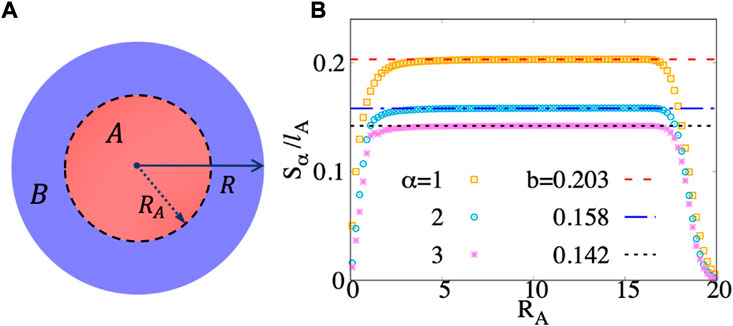
FIGURE 1. (A) Smooth circular cut with radius RA in a finite disk. (B) Prefactor of the area law for α-Rényi entropies. The well-developed plateau appears when RA is larger than 1.0lB and smaller than the radius of the system.
3 Corner contribution
In this section, we consider a non-smooth partition as shown in Figure 2. The subsystem A is a fan-shaped region with a corner angle θ at the center of the disk. Supposing the arc-shaped boundary is far away from the physical edge of the disk, then the EE is still in the area law region. The non-smooth cutting gives one corner of θ-degree at the center and two corners of
with the boundary length lA = 2RA + θRA. In order to screen out the pure angle contribution Sα(θ), we subtract the value at θ = π with the same RA. In this case, we have Sα(π) = 0 and lA = 2RA + πRA. Therefore, the residual entropy is ΔSα = bα(θ − π)RA + Sα(θ) in which the first term could be exactly obtained from the previous section supposing the area law and corner contributions are independent of each other.
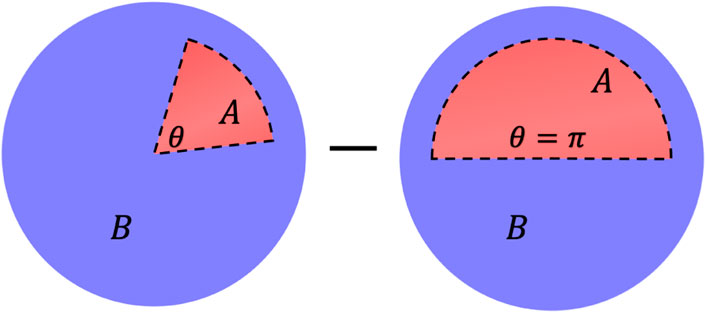
FIGURE 2. The non-smooth cutting schematic diagram of a bipartite finite disk and the subtraction rule is applied to extract pure angle contribution.
In Figure 3, we plot the Sα(θ) = ΔSα − bα(θ − π)RA as a function of the angle θ. A recent work in Ref. 13 discussed a similar bipartition by calculating the Rényi entropy via the cumulants of the particle number in subsystem Sα = ∑msα(m)κ2m, where κm are the even cumulants of the particle number distribution in region A. In particular, κ = κ2 is the variance of the number of particles in region A which was obtained analytically for the IQH case, namely,

FIGURE 3. θ-Dependence of the corner contribution in Rényi entropy for 171 electrons. After fitting the data by Sα(θ) = uα [1 + (π − θ) cot(θ)], we find that u1 = −0.0861 (±0.0009), u2 = −0.0613 (±0.0007) and u3 = −0.0531 (±0.0006) which are consistent with the conjecture
To look more clearly into the corner contribution of the EE, we treat the correlation matrix as entanglement Hamiltonian. The eigenstate which has the most important contribution in the EE is the one that has an eigenvalue near 1/2. In Figure 4, we plot the single particle density for the state which has an eigenvalue with the smallest
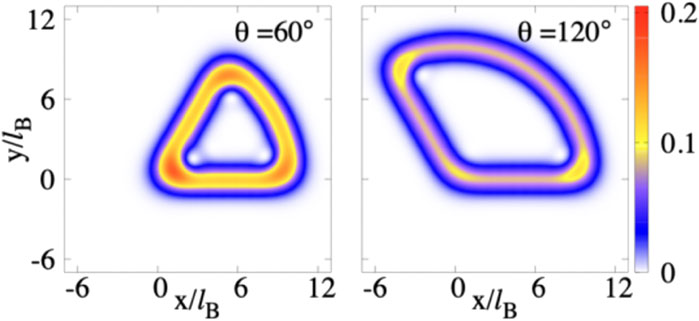
FIGURE 4. Single particle density for the state which has eigenvalue with the smallest
Now we consider a realistic system with a corner. We suppose that the particles live in a fan-shaped geometry and glue it to a cone as shown in Figure 5. The quantum Hall state on a cone has been realized experimentally in synthetic Landau levels for photons [38, 39]. In this case, the Landau wave functions [40–43] come to be
where
In Figure 6, we plot the radial density of the IQH state for different βs. β = 1 corresponds to the original disk geometry which has density
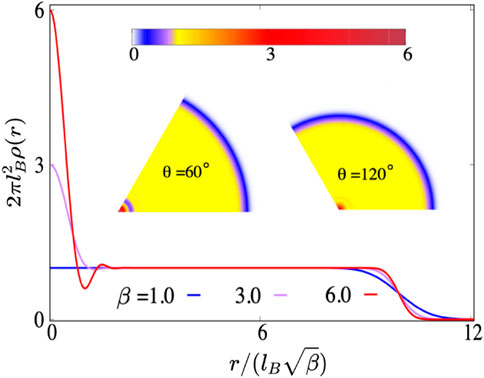
FIGURE 6. Radial density of the IQH state for 50 electrons with βs. β = 1 corresponds to the original disk geometry which has density
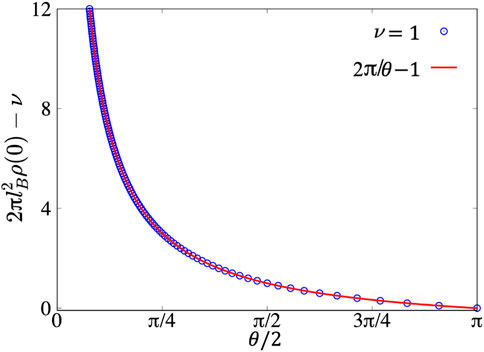
FIGURE 7. Accumulation of density at the tip for IQH state ρ(0). The data are perfectly fitted by f(θ) = 2π/θ − 1.
Therefore, we obtain the exact corner contribution of the EE via the fan-shaped bi-partition in the bulk. We found the 1/θ divergence of the corner contribution near θ → 0 which has similarity to the charge density cumulation at the tip once we put the system on a cone. The similarity between the EE and the local charge density or its fluctuation has been studied in several systems, either the classical or quantum many-body systems [30, 44].
4 Edge contribution and its universality
If we extend the region A in the radial direction to infinity, its arc-shape boundary is the physical edge of the system. As shown in Figure 8, now the EE between A and B contains the area law contribution from the radial boundary, a θ-angle contribution at the center, two
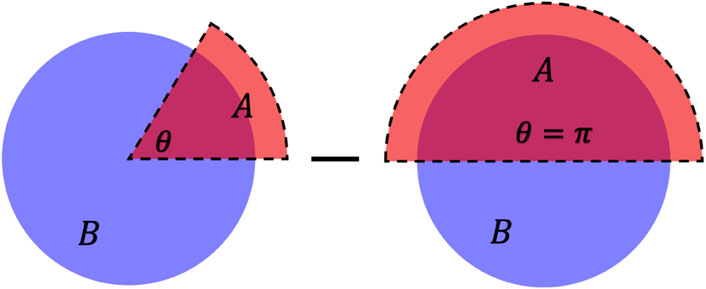
FIGURE 8. The same cutting scheme as Figure 2 has the subsystem A containing the physical boundary. A similar subtraction rule is applied to extract the corner and edge contribution.
Similar to the previous section, after subtracting the EE at θ = π, the area law term and Sα(π/2) are eliminated. Now the residual EE contains the corner and edge contributions. ΔS = Sα(θ) + Sedge(θ) − Sedge(π). The CFT predicts [13, 45, 46] that the EE of the chiral edge is equal to
which is independent of the RA. Here, we suppose the previous results of the corner keep invariant as S(θ) = uα[1 + (π − θ) cot θ] and fit the data of ΔS by function
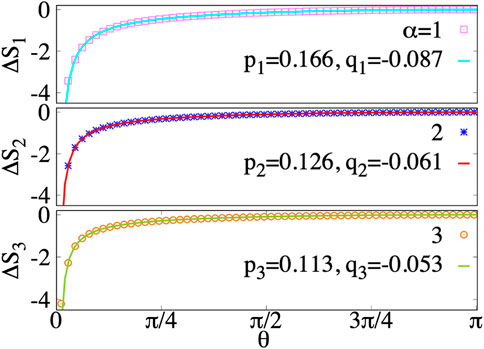
FIGURE 9. θ-Dependence of corner-edge contribution for Rényi entropy. The data are fitted by
To see how robust the edge contribution of EE is, we consider the edge reconstruction [47–49] pattern as shown in Figure 10. The system contains two unconnected parts. One is the IQH state at the center with N1 electrons, the other is the reconstructed part with N3 electrons, and we assume that they form the same IQH state at ν = 1. In the middle, there are N2 unoccupied orbitals. In this case, although there are three chiral edge modes, the inner edge of the reconstructed stripe has opposite chirality to that of the other two edges. Therefore, the total chirality is not affected by the edge reconstruction. We follow the same logic of subtracting the EE at θ = π as the unreconstructed case. We fix the total number of orbitals N = N1 + N2 + N3 = 171 and consider several combinations of different {Ni}. The fitting parameters are shown in Table 1. Here we only show the results of S1, and the results for other Sαs could be expected. It shows that the p1 and q1 are very robust and consistent with the previous unreconstructed results.
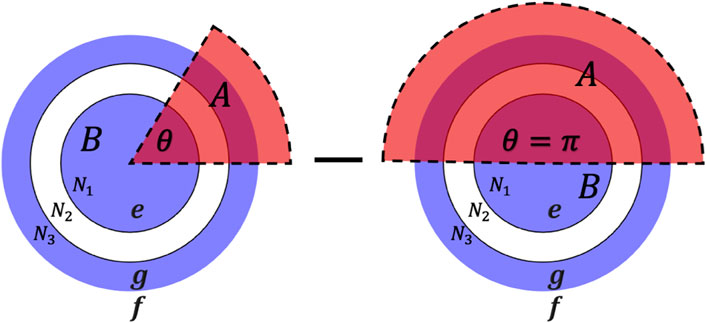
FIGURE 10. Non-smooth cutting schematic diagram of a disk that occurs in edge reconstruction. The system contains two unconnected parts containing N1 electrons in bulk and N3 electrons in the edge, respectively, and they are separated by N2 orbits. There are three chiral edge modes, and the inner edge of the reconstructed stripe has opposite chirality to that of the other two edges. By the same subtraction rule, we extract pure angle contribution and edge contribution.
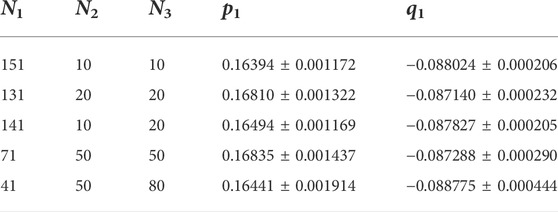
TABLE 1. Corner and edge contribution for S1 of a finite disk in an edge reconstructed pattern. We fix the total number of orbitals N = N1 + N2 + N3 = 171 and consider several combinations of different {Ni}. It shows that the p1 and q1 are very robust and consistent with the previous unreconstructed results.
5 Discussions and conclusions
As a conclusion, in the IQH state on a finite disk, we used a simple unified bipartite method to explore the independent EE contributions from the area law, the sharp corner, and the gapless chiral edge contributions. The coefficients of the area law bα are found to be universal and analytically solvable. With the exact area law term, we obtained the angle dependence of the corner contribution. It has a fixed prefactor, and the behaviors at θ → 0 are consistent with the tip charge accumulation of a realistic IQH liquid on a cone surface. It is similar to recent work of Ref. 30 in which the θ dependence of particle number fluctuations at the corner was found to be universal and has the same 1/θ behavior while θ → 0. While the fan-shaped subsystem contains the edge of the disk, the gapless chiral quantum Hall edge contributes a logarithmic type of EE in which the central charge c in its prefactor is as expected by its underlying CFT. Moreover, we found the edge reconstruction of the IQH does not change any of the prefactors due to the conservation of the chirality.
Here we should note that the correlation matrix method is only applicable to the non-interacting case, such as the IQH state. For the interacting case, namely, the fractional quantum Hall (FQH) states, the direct calculation of the reduced density matrix with breaking the rotational symmetry on a disk is complicated and limited to a small system size. However, as was expected from the charge fluctuation calculations, we believe that our bipartite method is also applicable, and the corner contribution in the FQH states still obeys the same universality, especially in the limit θ → 0 where the charge densities at the tip are the same. The FQH edge also contributes a logarithmic type of EE which has a prefactor with its corresponding central charge.
Data availability statement
The raw data supporting the conclusion of this article will be made available by the authors, without undue reservation.
Author contributions
DY and YY wrote the EE code and calculated the EE. QL contributed the analysis of IQH on the cone. Z-XH proposed the project and wrote the manuscript.
Funding
This work was supported by National Natural Science Foundation of China Grant No. 11974064, the Chongqing Research Program of Basic Research and Frontier Technology Grant No. cstc2021jcyjmsxmX0081, Chongqing Talents: Exceptional Young Talents Project No. cstc2021ycjh-bgzxm0147, and the Fundamental Research Funds for the Central Universities Grant No. 2020CDJQY-Z003. QL is supported by National Natural Science Foundation of China Grant No. 61988102.
Conflict of interest
The authors declare that the research was conducted in the absence of any commercial or financial relationships that could be construed as a potential conflict of interest.
Publisher’s note
All claims expressed in this article are solely those of the authors and do not necessarily represent those of their affiliated organizations, or those of the publisher, the editors, and the reviewers. Any product that may be evaluated in this article, or claim that may be made by its manufacturer, is not guaranteed or endorsed by the publisher.
References
1. Amico L, Fazio R, Osterloh A, Vedral V. Entanglement in many-body systems. Rev Mod Phys (2008) 80:517–76. doi:10.1103/revmodphys.80.517
2. Wen XG. Theory of the edge states in fractional quantum Hall effects. Int J Mod Phys B (1992) 6:1711–62. doi:10.1142/s0217979292000840
3. Holzhey C, Larsen F, Wilczek F. Geometric and renormalized entropy in conformal field theory. Nucl Phys B (1994) 424:443–67. doi:10.1016/0550-3213(94)90402-2
4. Vidal G, Latorre JI, Rico E, Kitaev A. Entanglement in quantum critical phenomena. Phys Rev Lett (2003) 90:227902. doi:10.1103/physrevlett.90.227902
5. Calabrese P, Cardy J. Entanglement entropy and quantum field theory. J Stat Mech : Theor Exp (2004) 0406:06002. doi:10.1088/1742-5468/2004/06/p06002
6. Tsui DC, Störmer HL, Gossard AC. Two-dimensional magnetotransport in the extreme quantum limit. Phys Rev Lett (1982) 48:1559–62. doi:10.1103/physrevlett.48.1559
7. Laughlin RB. Anomalous quantum Hall effect: An incompressible quantum fluid with fractionally charged excitations. Phys Rev Lett (1983) 50:1395–8. doi:10.1103/physrevlett.50.1395
8. Kitaev A, Preskill J. Topological entanglement entropy. Phys Rev Lett (2006) 96:110404. doi:10.1103/physrevlett.96.110404
9. Levin M, Wen XG. Detecting topological order in a ground state wave function. Phys Rev Lett (2006) 96:110405. doi:10.1103/physrevlett.96.110405
10. Li H, Haldane FDM. Entanglement spectrum as a generalization of entanglement entropy: Identification of topological order in non-abelian fractional quantum Hall effect states. Phys Rev Lett (2008) 101:010504. doi:10.1103/physrevlett.101.010504
11. Chandran A, Hermanns M, Regnault N, Bernevig BA. Bulk-edge correspondence in entanglement spectra. Phys Rev B (2011) 84:205136. doi:10.1103/physrevb.84.205136
12. Luo ZX, Pankovich BG, Hu Y, Wu YS. Correspondence between bulk entanglement and boundary excitation spectra in two-dimensional gapped topological phases. Phys Rev B (2019) 99:205137. doi:10.1103/physrevb.99.205137
13. Estienne B, Stephan JM. Entanglement spectroscopy of chiral edge modes in the quantum Hall effect. Phys Rev B (2020) 101:115136. doi:10.1103/physrevb.101.115136
14. Fradkin E. Field theories of condensed matter physics. Cambridge: Cambridge University Press (2013).
15. Solodukhin SN. Entanglement entropy, conformal invariance and extrinsic geometry. Phys Lett B (2008) 665:305–9. doi:10.1016/j.physletb.2008.05.071
16. Fradkin E, Moore JE. Entanglement entropy of 2D conformal quantum critical points: Hearing the shape of a quantum drum. Phys Rev Lett (2006) 97:050404. doi:10.1103/physrevlett.97.050404
17. Casini H, Huerta M. Entanglement entropy in free quantum field theory. J Phys A: Math Theor (2009) 42:504007. doi:10.1088/1751-8113/42/50/504007
18. Nishioka T, Ryu S, Takayanagi T. Holographic entanglement entropy: an overview. J Phys A: Math Theor (2009) 42:504008. doi:10.1088/1751-8113/42/50/504008
19. Myers RC, Sinha A. Seeing a c-theorem with holography. Phys Rev D (2010) 82:046006. doi:10.1103/physrevd.82.046006
20. Kallin AB, Hyatt K, Singh RRP, Melko RG. Entanglement at a two-dimensional quantum critical point: a numerical linked-cluster expansion study. Phys Rev Lett (2013) 110:135702. doi:10.1103/physrevlett.110.135702
21. Bueno P, Myers RC, Krempa WW. Corner contributions to holographic entanglement entropy. J High Energ Phys (2015) 2015:68. doi:10.1007/jhep08(2015)068
22. Faulkner T, Leigh RG, Parrikar O. Shape dependence of entanglement entropy in conformal field theories. J High Energ Phys (2016) 88:1–39. doi:10.1007/jhep04(2016)088
23. Laflorencie N. Quantum entanglement in condensed matter systems. Phys Rep (2016) 646:1–59. doi:10.1016/j.physrep.2016.06.008
24. Helmes J, Sierens LEH, Chandran A, Krempa WW, Melko RG. Universal corner entanglement of Dirac fermions and gapless bosons from the continuum to the lattice. Phys Rev B (2016) 94:125142. doi:10.1103/physrevb.94.125142
25. Chen X, Krempa WW, Faulkner T, Fradkin E. Two-cylinder entanglement entropy under a twist. J Stat Mech (2017) 4:043104. doi:10.1088/1742-5468/aa668a
26. Bueno P, Krempa WW. Bounds on corner entanglement in quantum critical states. Phys Rev B (2016) 93:045131. doi:10.1103/physrevb.93.045131
27. Krempa WW. Entanglement susceptibilities and universal geometric entanglement entropy. Phys Rev B (2019) 99:075138. doi:10.1103/physrevb.99.075138
28. Rozon PG, Bplteau PA, Krempa WW. Geometric entanglement in the integer quantum Hall state at ν=1 with boundaries. Phys Rev B (2020) 102:155417. doi:10.1103/physrevb.102.155417
29. Sirois B, Fournier LM, Leduc J, Krempa WW. Geometric entanglement in integer quantum Hall states. Phys Rev B (2021) 103:115115. doi:10.1103/physrevb.103.115115
30. Estienne B, Stephan JM, Krempa WW. Cornering the universal shape of fluctuations. Nat Commun (2022) 13:287. doi:10.1038/s41467-021-27727-1
31. Peschel I. Calculation of reduced density matrices from correlation functions. J Phys A: Math Gen (2003) 36:L205–8. doi:10.1088/0305-4470/36/14/101
32. Sterdyniak A, Chandran A, Regnault N, Bernevig BA, Bonderson P. Real-space entanglement spectrum of quantum Hall states. Phys Rev B (2012) 85:125308. doi:10.1103/physrevb.85.125308
33. Dubail J, Read N, Rezayi EH. Real-space entanglement spectrum of quantum Hall systems. Phys Rev B (2012) 85:115321. doi:10.1103/physrevb.85.115321
34. Rodriguez ID, Simon SH, Slingerland JK. Evaluation of ranks of real space and particle entanglement spectra for large systems. Phys Rev Lett (2012) 108:256806. doi:10.1103/physrevlett.108.256806
35. Rodriguez ID, Sierra G. Entanglement entropy of integer quantum Hall states. Phys Rev B (2009) 80:153303. doi:10.1103/physrevb.80.153303
36. Hung LY, Myers RC, Smolkin M. Twist operators in higher dimensions. J High Energ Phys (2014) 10:178. doi:10.1007/jhep10(2014)178
37. Bueno P, Myers RC, Krempa WW. Universality of corner entanglement in conformal field theories. Phys Rev Lett (2015) 115:021602. doi:10.1103/PhysRevLett.115.021602
38. Schine N, Ryou A, Gromov A, Sommer A, Simon J. Synthetic Landau levels for photons. Nature (2016) 534:671–5. doi:10.1038/nature17943
39. Schine N, Chalupnik M, Can T, Gromov A, Simon J. Electromagnetic and gravitational responses of photonic Landau levels. Nature (2019) 565:173–9. doi:10.1038/s41586-018-0817-4
40. Bueno MJ, Furtado C, Carvalho AMd. M. Landau levels in graphene layers with topological defects. Eur Phys J B (2012) 85:53. doi:10.1140/epjb/e2011-20726-4
41. Biswas RR, Son DT. Fractional charge and inter-Landau–level states at points of singular curvature. Proc Natl Acad Sci U S A (2016) 113:8636–41. doi:10.1073/pnas.1609470113
42. Can T, Chiu YH, Laskin M, Wiegmann P. Emergent conformal symmetry and geometric transport properties of quantum Hall states on singular surfaces. Phys Rev Lett (2016) 117:266803. doi:10.1103/physrevlett.117.266803
43. Wu YH, Tu HH, Sreejith GJ. Fractional quantum Hall states of bosons on cones. Phys Rev A (Coll Park) (2017) 96:033622. doi:10.1103/physreva.96.033622
44. Jiang N, Li Q, Zhu Z, Hu Z-X. Universal properties of the FQH state from the topological entanglement entropy and disorder effects. Ann Phys (N Y) (2017) 384:225–34. doi:10.1016/j.aop.2017.07.005
45. Calabrese P, Cardy J. Entanglement entropy and conformal field theory. J Phys A: Math Theor (2009) 42:504005. doi:10.1088/1751-8113/42/50/504005
46. Berthiere C, Krempa WW. Relating bulk to boundary entanglement. Phys Rev B (2019) 100:235112. doi:10.1103/physrevb.100.235112
47. Chamon Cde C, Wen XG. Sharp and smooth boundaries of quantum Hall liquids. Phys Rev B (1994) 49:8227–41. doi:10.1103/physrevb.49.8227
48. Wan X, Yang K, Rezayi EH. Reconstruction of fractional quantum Hall edges. Phys Rev Lett (2002) 88:056802. doi:10.1103/physrevlett.88.056802
Keywords: entanglement entropy, quantum hall, geometric, edge, central charge
Citation: Ye D, Yang Y, Li Q and Hu Z-X (2022) Entanglement entropy of the quantum Hall edge and its geometric contribution. Front. Phys. 10:971423. doi: 10.3389/fphy.2022.971423
Received: 17 June 2022; Accepted: 19 October 2022;
Published: 10 November 2022.
Edited by:
Peng Yan, University of Electronic Science and Technology of China, ChinaReviewed by:
Wei Zhu, Westlake University, ChinaWilliam Witczak-Krempa, Université de Montréal, Canada
Copyright © 2022 Ye, Yang, Li and Hu. This is an open-access article distributed under the terms of the Creative Commons Attribution License (CC BY). The use, distribution or reproduction in other forums is permitted, provided the original author(s) and the copyright owner(s) are credited and that the original publication in this journal is cited, in accordance with accepted academic practice. No use, distribution or reproduction is permitted which does not comply with these terms.
*Correspondence: Zi-Xiang Hu, enhodUBjcXUuZWR1LmNu
†These authors have contributed equally to this work
 Dan Ye
Dan Ye Yi Yang
Yi Yang Qi Li
Qi Li Zi-Xiang Hu
Zi-Xiang Hu